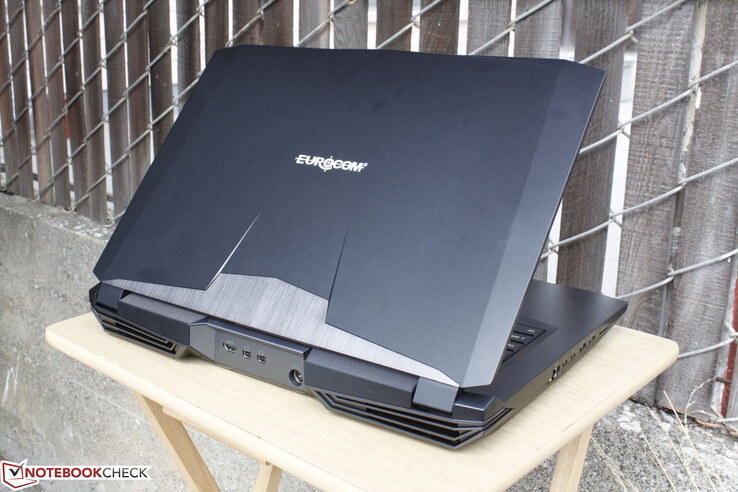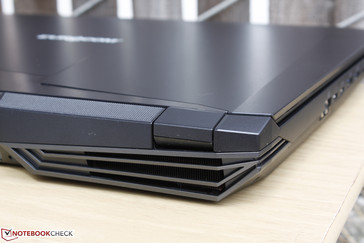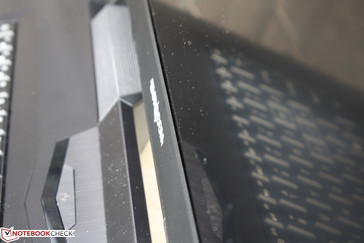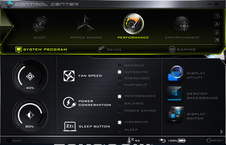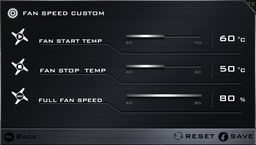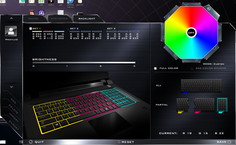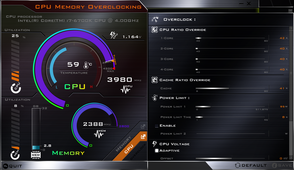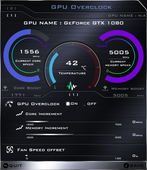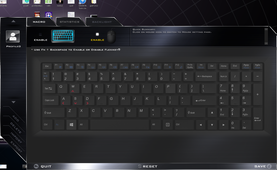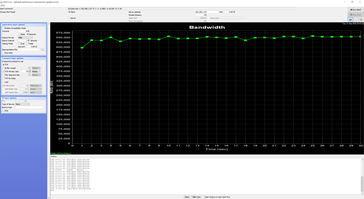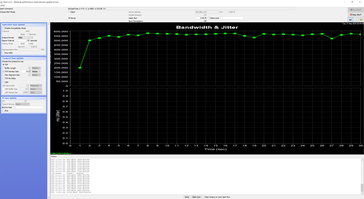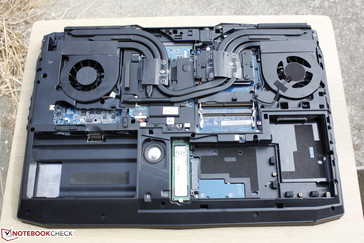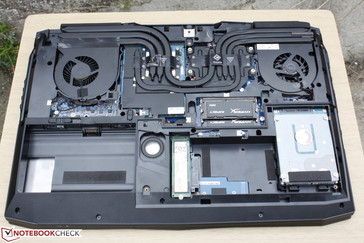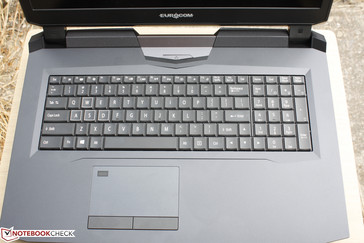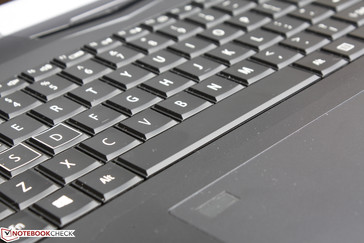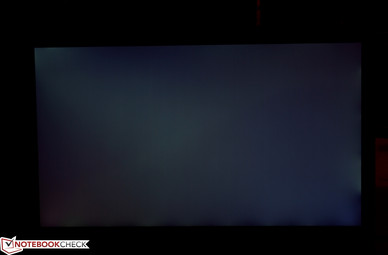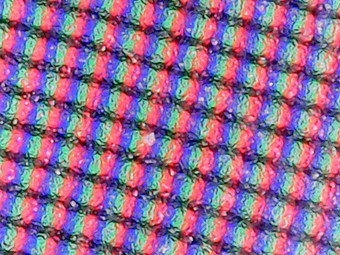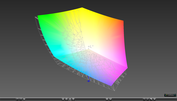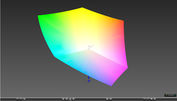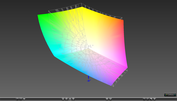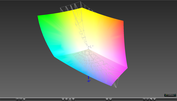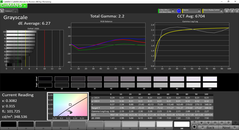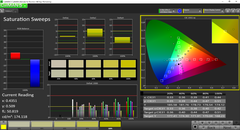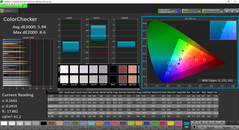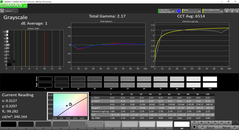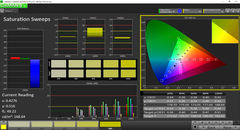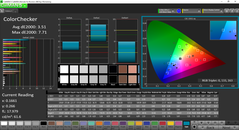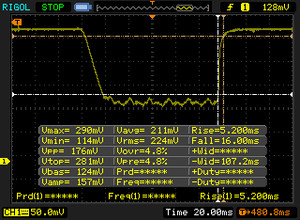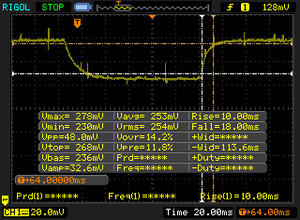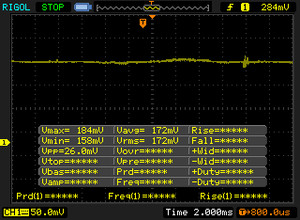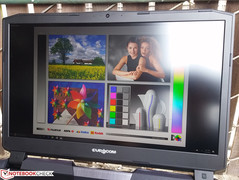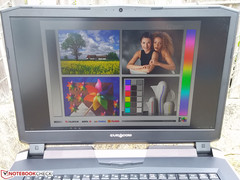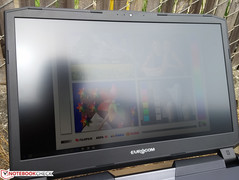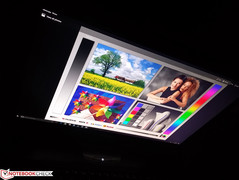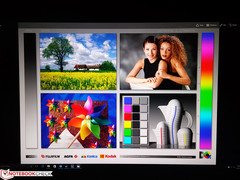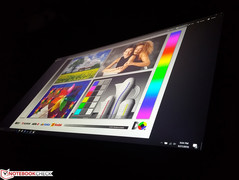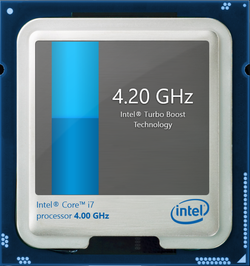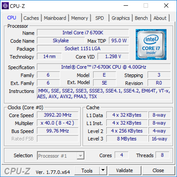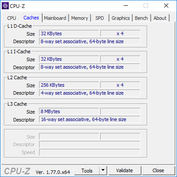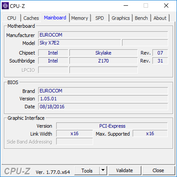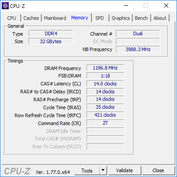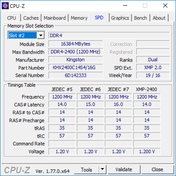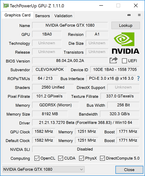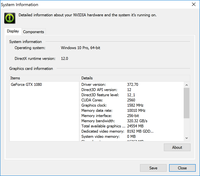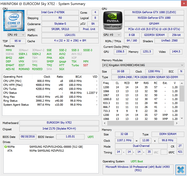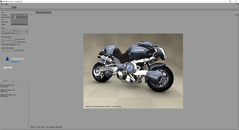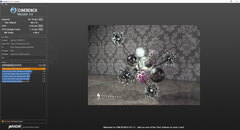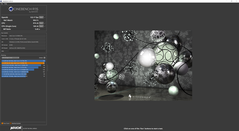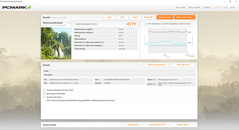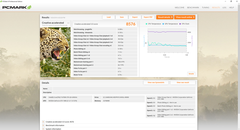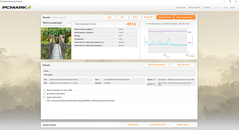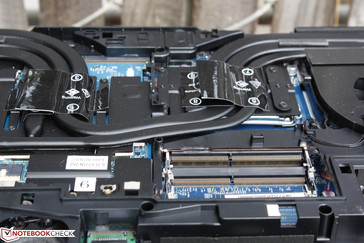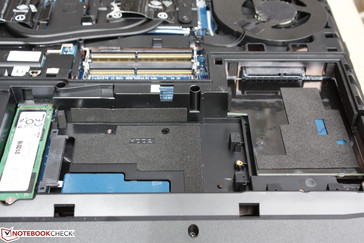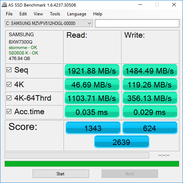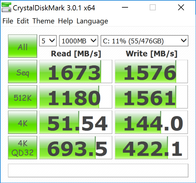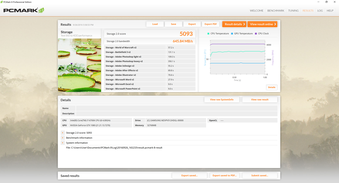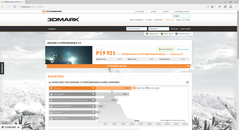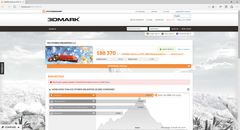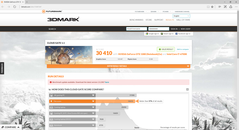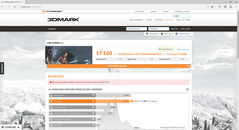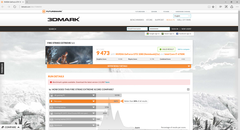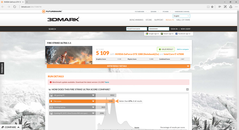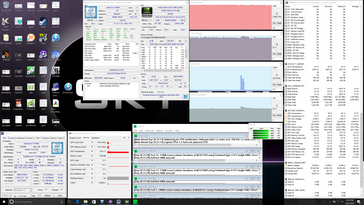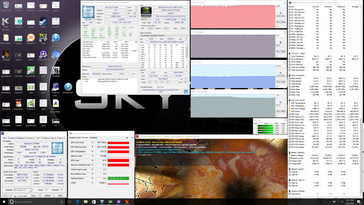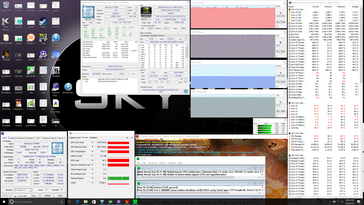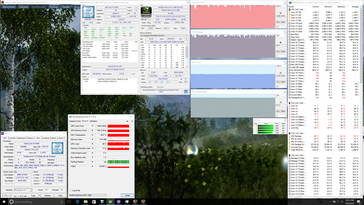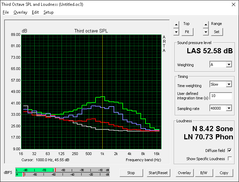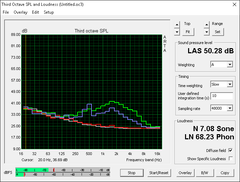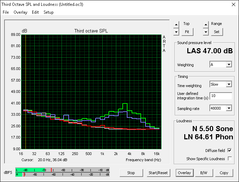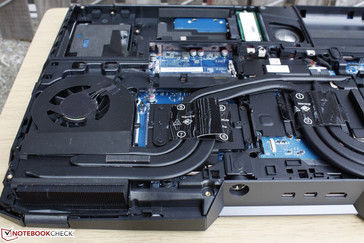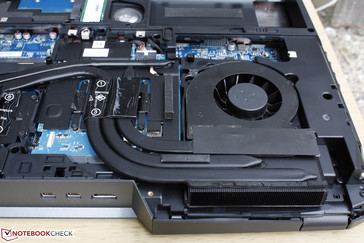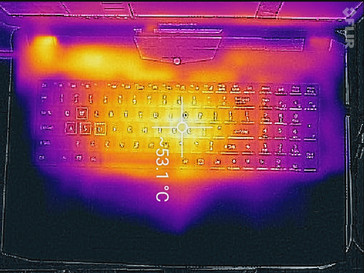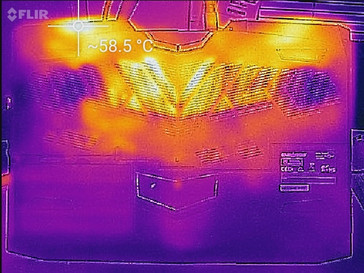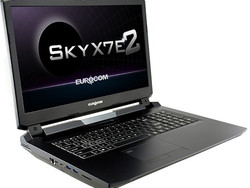Eurocom Sky X7E2 (Clevo P775DM3) Notebook Review
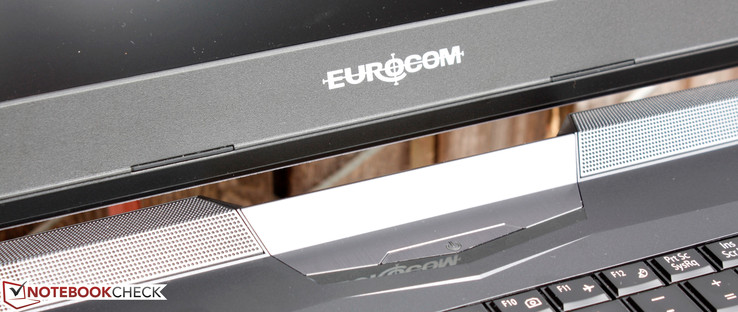
Clevo barebones are some of the most powerful and versatile systems as far as gaming and professional notebooks are concerned. Most newer models now offer standard desktop LGA sockets and MXM 3.0 slots for more end-user customization than what other big name gaming manufacturers currently offer. This advantage alone should appeal to enthusiasts who intend to frequently tinker and upgrade core components.
Our latest 17.3-inch model comes from Eurocom as the Sky X7E2. The system utilizes the Clevo P775DM3 Eurocom Sky DLX7 (Clevo P775DM1) Notebook Reviewchassis that is visually similar to last year's Eurocom Sky DLX7 based on the Clevo P775DM1, albeit with some important internal differences relating to the cooling solution. We recommend checking out our existing review page on the P775DM1 as nearly all of our comments apply here on the Sky X7E2. Can a system this size sufficiently run a 91 W TDP CPU and a ~150 W TDP GPU without any compromises?
Recent 17.3-inch Clevo reviews:
Case
We've already discussed case quality on our existing review page of the Sky DLX7 and we will go over it again just briefly here. Workmanship is excellent from top to bottom with no defects between material transitions on our particular test unit. The plastic base is rigid with no creaking and only very minimal flexing when applying pressure around the keyboard. The lid flexes and warps more easily than the base as to be expected, but not by any worrying degree.
Our main complaints carry over from our previous Clevo P775DM1 test unit in that the rear horizontal ventilation grilles can easily snap and bend in addition to the noticeable gap between the inner display bezel and bottom edge of the screen (as pictured below). This latter issue occurs on MSI notebooks as well, so Eurocom is not alone in this regard.
In terms of size and weight, the Sky X7E2 is heavier than a handful of 17-inch competitors by a few hundred grams with the recent Lenovo Y900 being a notable exception. Configure the Eurocom with some 2.5-inch HDDs, however, and the weight will be about the same. The chassis is thicker than most save for the recently released MSI GT73VR.
Connectivity
Available ports include 4x USB 3.0 with 2x USB Type-C on the left edge of which only one supports Thunderbolt 3. All video-out ports are located on the rear including the HDMI 2.0 port whereas most other gaming systems are still shipping with HDMI 1.4 or older. This means that the Eurocom is able to output at up to 4K and at 60 FPS to pair up nicely with the powerful GTX 1080.
We would have liked to see a VGA port like on some Aorus notebooks or even more USB 3.0 ports like on the GT72VR. The Alienware 17 sports a Graphics Amplifier port for supporting desktop graphics cards.
Software
Newer Clevo barebones now carry a software suite for toggling system settings and overclocking components including the CPU, GPU, and RAM. The overclocking utility is more visually appealing than MSI Afterburner while being just as easy to use. The downside is that there is no single compact window with settings for both the CPU and GPU, so the desktop or taskbar can become cluttered with multiple overclocking utilities open.
FlexiKey hasn't changed since its introduction to combat MSI's Dragon Center software. The intuitive software offers easy access to power settings and fan controls, though it includes no toggling of preset color settings like sRGB or AdobeRGB unlike on the MSI equivalent.
SD Card Reader
The SDXC card reader is capable of read rates of at least 257 MB/s to be one of the fastest in our database so far. Note that our Toshiba Exceria Pro UHS-II SD test card is rated for a read rate of 260 MB/s, so the reader is essentially able to utilize the maximum performance out of our test card. Transferring 1 GB of photos from the SD card to desktop takes less than 6 seconds.
| SD Card Reader | |
| average JPG Copy Test (av. of 3 runs) | |
| Asus G701VO-CS74K | |
| Eurocom Sky X7E2 | |
| MSI GT73VR-6RE16SR451 | |
| maximum AS SSD Seq Read Test (1GB) | |
| Eurocom Sky X7E2 | |
| Asus G701VO-CS74K | |
| MSI GT73VR-6RE16SR451 | |
Communication
WLAN is provided by a Killer 1535 module capable of theoretical transfer rates of up to 867 Mbps. A real-world test with Jperf settings as shown below results in transfer rates of just under 550 Mbps when standing one meter away from our Linksys E8500 test router. Like other gaming systems with the same Killer WLAN card, the Sky X7E2 ships with the Killer Network Manager software for quick toggling of settings and program network priorities.
| Networking | |
| iperf Server (receive) TCP 1 m 512KB | |
| Eurocom Sky X7E2 | |
| Lenovo IdeaPad Y900 | |
| Asus G701VO-CS74K | |
| iperf Client (transmit) TCP 1 m 512KB | |
| Eurocom Sky X7E2 | |
| Lenovo IdeaPad Y900 | |
| Asus G701VO-CS74K | |
Accessories
Eurocom throws in a wider range of extras compared to what others have available. This includes thermal paste, spare screws, drivers disc, manual, and padding cubes for when installing secondary 2.5-inch drives.
Maintenance
Serviceability is almost always easy on a Clevo barebones. The two bottom panels can be removed with a standard Philips screwdriver and, unlike on MSI G series systems, are only held in place by just a couple of screws.
Users have easy access to the MXM 3.0 slot, LGA 1151 socket, 2x SODIMM slots, 3x storage bays, and removable battery. Additional disassembly is required to access to the last M.2 2280 storage slot, M.2 2230 WLAN slot, and the last two SODIMM slots. Note the difference in cooling between the Sky X7E2 (P775DM3) and the Sky DLX7 (P775DM1); the latter Eurocom system is a few hundred grams heavier than the X7E2 due in part to this small difference.
Warranty
The standard one-year limited warranty applies with every new purchase compared to two years from most major gaming notebook manufacturers like Gigabyte and MSI. Users who want two or three years of coverage from Eurocom will have to pony up $146 and $313 USD, respectively.
Input Devices
Keyboard & Touchpad
No changes have been made to the keyboard and touchpad since our last outing with the Clevo P775DM1 chassis. The keys clatter slightly louder when compared to competing 17-inch notebooks like the Asus G701/752 series or Alienware 17, but travel and feedback are both firm due to the solid foundation underneath. The beveled layout can feel cramped to users who may be more accustomed to the common chiclet layout since the latter provides more space between keys.
We would like to see dedicated Macro keys or auxiliary keys to better cater to the gaming crowd in the future. Additionally, individually-lit keys are becoming more common on gaming-centric notebooks like the Razer Blade Stealth and Aorus series, so we expect to see the same from Clevo on future revisions. The Sky X7E2 offers "only" three levels of RGB backlight brightness split across three different regions of the keyboard.
Display
Eurocom joins a growing number of gaming notebook manufacturers including Aorus and MSI in offering 120 Hz display options. Users have the option between a standard FHD IPS 60 Hz panel, 4K UHD IPS 60 Hz panel, FHD IPS 120 Hz panel, or a QHD TN 120 Hz/5 ms panel. The panels each sport different response times, contrast ratios, and gamuts as well, so users ought to pick the panel that best suits their daily needs.
Our test unit is equipped with the matte 4K UHD option that advertises 1000:1 contrast ratio, complete AdobeRGB coverage, and a 400 nit display backlight. Measurements with our own equipment paint a slightly different picture with a 91 percent coverage of AdobeRGB and an average backlight brightness of about 330 nits. Contrast ratio is otherwise as advertised according to our X-Rite spectrophotometer. A quick search on its AU Optronics B173ZAN01.0 panel shows it to be a common find on other Clevo barebones and even on some competing 17-inch gaming notebooks including the Alienware 17 R3 and the MSI GT73VR.
There is a slight graininess to our 4K UHD panel that becomes more apparent when on maximum brightness while displaying a white background. This phenomenon is common on matte panels compared to glossy, but it seems to be more noticeable here on the Eurocom than on the recent GT72VR. Otherwise, text is extremely crisp and colors are noticeably brighter and deeper compared to budget panels on cheaper notebooks. Slight backlight bleeding is noticeable around the edges and corners when displaying a dark background on our specific test unit. Fortunately, it's not severe enough to be a distraction when gaming or watching movies.
| |||||||||||||||||||||||||
Brightness Distribution: 87 %
Center on Battery: 332.6 cd/m²
Contrast: 1059:1 (Black: 0.314 cd/m²)
ΔE ColorChecker Calman: 5.94 | ∀{0.5-29.43 Ø4.78}
ΔE Greyscale Calman: 6.27 | ∀{0.09-98 Ø5}
100% sRGB (Argyll 1.6.3 3D)
91% AdobeRGB 1998 (Argyll 1.6.3 3D)
99.2% AdobeRGB 1998 (Argyll 3D)
100% sRGB (Argyll 3D)
86.6% Display P3 (Argyll 3D)
Gamma: 2.2
CCT: 6704 K
| Eurocom Sky X7E2 IPS, 17.3", 3840x2160 | MSI GT73VR-6RE16SR451 N173HHE-G32 (CMN1747), TN, 17.3", 1920x1080 | Asus G701VO-CS74K IPS, 17.3", 1920x1080 | Lenovo IdeaPad Y900 17.3", 1920x1080 | Alienware 17 R3 (A17-9935) CV69H_173WF4 (LGD0459), IPS, 17.3", 1920x1080 | |
|---|---|---|---|---|---|
| Display | -3% | -23% | -24% | -26% | |
| Display P3 Coverage (%) | 86.6 | 91.2 5% | 68.8 -21% | 67.4 -22% | 66.9 -23% |
| sRGB Coverage (%) | 100 | 100 0% | 87.7 -12% | 86.3 -14% | 83.9 -16% |
| AdobeRGB 1998 Coverage (%) | 99.2 | 84.9 -14% | 64.1 -35% | 63.2 -36% | 61.4 -38% |
| Response Times | 38% | -15% | -23% | -13% | |
| Response Time Grey 50% / Grey 80% * (ms) | 28 ? | 26 ? 7% | 29.2 ? -4% | 34.8 ? -24% | 33 ? -18% |
| Response Time Black / White * (ms) | 21.2 ? | 6.8 ? 68% | 26.4 ? -25% | 25.6 ? -21% | 23 ? -8% |
| PWM Frequency (Hz) | |||||
| Screen | -18% | 1% | -2% | -7% | |
| Brightness middle (cd/m²) | 332.6 | 314 -6% | 368.1 11% | 344.9 4% | 360 8% |
| Brightness (cd/m²) | 329 | 294 -11% | 349 6% | 329 0% | 336 2% |
| Brightness Distribution (%) | 87 | 89 2% | 86 -1% | 86 -1% | 90 3% |
| Black Level * (cd/m²) | 0.314 | 0.23 27% | 0.365 -16% | 0.349 -11% | 0.44 -40% |
| Contrast (:1) | 1059 | 1365 29% | 1008 -5% | 988 -7% | 818 -23% |
| Colorchecker dE 2000 * | 5.94 | 9.74 -64% | 4.16 30% | 4.49 24% | 4.76 20% |
| Colorchecker dE 2000 max. * | 8.6 | 15.71 -83% | 8.7 -1% | 8.72 -1% | 10.8 -26% |
| Greyscale dE 2000 * | 6.27 | 9.58 -53% | 3.86 38% | 4.63 26% | 3.69 41% |
| Gamma | 2.2 100% | 2.5 88% | 2.19 100% | 2.11 104% | 2.24 98% |
| CCT | 6704 97% | 11854 55% | 6892 94% | 6905 94% | 6091 107% |
| Color Space (Percent of AdobeRGB 1998) (%) | 91 | 76 -16% | 57.6 -37% | 56.7 -38% | 55 -40% |
| Color Space (Percent of sRGB) (%) | 100 | 100 0% | 87.6 -12% | 86.4 -14% | 84 -16% |
| Total Average (Program / Settings) | 6% /
-7% | -12% /
-6% | -16% /
-9% | -15% /
-12% |
* ... smaller is better
It's not uncommon for Eurocom to offer wide color gamut options and the panel on our unit is capable of much deeper and more accurate colors than what most of the competition can provide. This isn't as vital to the gaming experience as response times or black levels, but digital artists can appreciate the larger color space.
Colors and grayscale out of the box are average. A quick calibration against the sRGB standard greatly improves both grayscale and RGB balance, though additional calibration is required to get more accurate colors at higher saturation levels.
Display Response Times
| ↔ Response Time Black to White | ||
|---|---|---|
| 21.2 ms ... rise ↗ and fall ↘ combined | ↗ 5.2 ms rise | |
| ↘ 16 ms fall | ||
| The screen shows good response rates in our tests, but may be too slow for competitive gamers. In comparison, all tested devices range from 0.1 (minimum) to 240 (maximum) ms. » 46 % of all devices are better. This means that the measured response time is similar to the average of all tested devices (20.2 ms). | ||
| ↔ Response Time 50% Grey to 80% Grey | ||
| 28 ms ... rise ↗ and fall ↘ combined | ↗ 10 ms rise | |
| ↘ 18 ms fall | ||
| The screen shows relatively slow response rates in our tests and may be too slow for gamers. In comparison, all tested devices range from 0.165 (minimum) to 636 (maximum) ms. » 36 % of all devices are better. This means that the measured response time is better than the average of all tested devices (31.6 ms). | ||
Screen Flickering / PWM (Pulse-Width Modulation)
| Screen flickering / PWM not detected | |||
In comparison: 53 % of all tested devices do not use PWM to dim the display. If PWM was detected, an average of 8111 (minimum: 5 - maximum: 343500) Hz was measured. | |||
Outdoor visibility is average at best. The backlight was not designed to overcome direct sunlight or overcast, but it's sufficient for working under shade if outdoor use is unavoidable. The hinges open up to a maximum of about 140 degrees while the matte IPS panel both reduces glare and allows for wider viewing angles.
Performance
Most Clevo barebones are extremely versatile when it comes to configurable components. Eurocom offers multiple CPU and GPU choices with optional G-Sync for all display types. RAM and storage options are even wider with 4x SODIMM slots and 4x storage bays to work with. Our test model is equipped with the highest CPU and GPU option available: The Core i7-6700K and the GeForce GTX 1080. Such a combination should show us just how well the P775DM3 can handle high TDP components that are uncommonly found together in notebooks.
Optimus is not included even if the user chooses to opt out of G-Sync.
Processor
CPU performance according to CineBench benchmarks is nearly identical to the DogHouse Mobius SS that utilizes a Clevo chassis with the same Core i7-6700K desktop CPU. Users can expect a multi-core performance boost of about 20 to 30 percent over the much more common i7-6700HQ or the overclockable i7-6820HK found on most other gaming notebooks. The power envelope of the i7-6700K is over twice that of the i7-6700HQ, however, so the higher speeds come at the cost of significantly higher power consumption.
See our dedicated CPU page on the Core i7-6700K for more technical information and benchmark comparisons.
| Cinebench R15 | |
| CPU Single 64Bit | |
| DogHouse Systems Mobius SS | |
| Eurocom Sky X7E2 | |
| MSI GE62 2QC-468XPL | |
| MSI GT72VR 6RD-063US | |
| EVGA SC17 | |
| Asus GL550JK-CN391H | |
| CPU Multi 64Bit | |
| Eurocom Sky X7E2 | |
| DogHouse Systems Mobius SS | |
| MSI GE62 2QC-468XPL | |
| EVGA SC17 | |
| MSI GT72VR 6RD-063US | |
| Asus GL550JK-CN391H | |
| Cinebench R11.5 | |
| CPU Single 64Bit | |
| DogHouse Systems Mobius SS | |
| EVGA SC17 | |
| Eurocom Sky X7E2 | |
| MSI GE62 2QC-468XPL | |
| MSI GT72VR 6RD-063US | |
| Asus GL550JK-CN391H | |
| CPU Multi 64Bit | |
| DogHouse Systems Mobius SS | |
| Eurocom Sky X7E2 | |
| MSI GE62 2QC-468XPL | |
| EVGA SC17 | |
| MSI GT72VR 6RD-063US | |
| Asus GL550JK-CN391H | |
| Cinebench R10 | |
| Rendering Multiple CPUs 32Bit | |
| DogHouse Systems Mobius SS | |
| Eurocom Sky X7E2 | |
| MSI GE62 2QC-468XPL | |
| EVGA SC17 | |
| MSI GT72VR 6RD-063US | |
| Rendering Single 32Bit | |
| DogHouse Systems Mobius SS | |
| Eurocom Sky X7E2 | |
| EVGA SC17 | |
| MSI GE62 2QC-468XPL | |
| MSI GT72VR 6RD-063US | |
| wPrime 2.10 - 1024m | |
| MSI GT72VR 6RD-063US | |
| EVGA SC17 | |
| MSI GE62 2QC-468XPL | |
| Eurocom Sky X7E2 | |
| DogHouse Systems Mobius SS | |
| Super Pi Mod 1.5 XS 32M - 32M | |
| MSI GT72VR 6RD-063US | |
| MSI GE62 2QC-468XPL | |
| EVGA SC17 | |
| DogHouse Systems Mobius SS | |
| Eurocom Sky X7E2 | |
* ... smaller is better
System Performance
PCMark benchmarks rank the Sky X7E2 in the same ballpark as competing 17-inch gaming notebooks if not slightly slower in some cases.
While the system is subjectively very fast when multi-tasking and launching applications, we experienced a number of crashes that required cold reboots. These all occurred when gaming or when waking from sleep and Eurocom has pinpointed the issue to the graphics driver. Our tests were performed on driver 372.70, which was the latest from Nvidia at the time of review.
| PCMark 8 | |
| Home Score Accelerated v2 | |
| Asus G701VO-CS74K | |
| MSI GT73VR-6RE16SR451 | |
| Lenovo IdeaPad Y900 | |
| Eurocom Sky X7E2 | |
| Work Score Accelerated v2 | |
| Asus G701VO-CS74K | |
| Lenovo IdeaPad Y900 | |
| MSI GT73VR-6RE16SR451 | |
| Eurocom Sky X7E2 | |
| Creative Score Accelerated v2 | |
| Eurocom Sky X7E2 | |
| Asus G701VO-CS74K | |
| Lenovo IdeaPad Y900 | |
| PCMark 8 Home Score Accelerated v2 | 4579 points | |
| PCMark 8 Creative Score Accelerated v2 | 8576 points | |
| PCMark 8 Work Score Accelerated v2 | 4816 points | |
Help | ||
Storage Devices
A total of four internal storage bays are available (2x M.2 2280 PCIe Gen 3 RAID 0/1, 2x 2.5-inch SATA III RAID 0/1). The SATA III bays can support both 7 mm and 9.5 mm drives whereas most thinner notebooks can only hold 7 mm SSDs or HDDs.
Our test model comes equipped with the same 512 GB Samsung SM951 NVMe SSD that can also be found on other high-end gaming notebooks with read and write rates above 1500 MB/s. Having two of these in RAID 0 can deliver sequential read and write rates of around 3000 MB/s and 2500 MB/s, respectively.
See our table of HDDs and SSDs for more benchmark comparisons.
| Eurocom Sky X7E2 Samsung SM951 MZVPV512HDGL m.2 PCI-e | MSI GT73VR-6RE16SR451 2x Samsung SM951 MZVPV256HDGL (RAID 0) | Asus G701VO-CS74K 2x Samsung SM951 MZVPV512HDGL (RAID 0) | Lenovo IdeaPad Y900 Samsung SM951 MZVPV256 m.2 | MSI GT72VR 6RD-063US SanDisk SD8SN8U1T001122 | |
|---|---|---|---|---|---|
| CrystalDiskMark 3.0 | 35% | 22% | -15% | -62% | |
| Read Seq (MB/s) | 1673 | 3285 96% | 3067 83% | 1559 -7% | 469.8 -72% |
| Write Seq (MB/s) | 1576 | 2560 62% | 2434 54% | 1254 -20% | 435.2 -72% |
| Read 512 (MB/s) | 1180 | 1775 50% | 1582 34% | 850 -28% | 312.6 -74% |
| Write 512 (MB/s) | 1561 | 2327 49% | 2255 44% | 1228 -21% | 367.3 -76% |
| Read 4k (MB/s) | 51.5 | 52.2 1% | 47.25 -8% | 49.32 -4% | 28.21 -45% |
| Write 4k (MB/s) | 144 | 153.1 6% | 110.7 -23% | 140.3 -3% | 59 -59% |
| Read 4k QD32 (MB/s) | 694 | 627 -10% | 584 -16% | 539 -22% | 339.7 -51% |
| Write 4k QD32 (MB/s) | 422.1 | 527 25% | 463.3 10% | 345.3 -18% | 225.6 -47% |
GPU Performance
The GTX 1080 is a powerhouse of a GPU. Surprisingly, 3DMark Fire Strike benchmarks place our Eurocom test unit consistently ahead of even our GTX 1080 Founder's Edition for desktop systems and it also edges out our MSI GT80 Titan with GTX 980M SLI graphics. Users can expect a raw performance boost of about 70 percent when moving up from a single GTX 980 or about 120 to 130 percent when moving up from a GTX 980M. It's been repeated ad nauseum around the web, but the Pascal series is a true generational leap over the previous Maxwell series.
See our dedicated GPU page on the GTX 1080 for more technical information and benchmark comparisons and our GTX 1080 review for more in-depth performance details.
| 3DMark 11 Performance | 19921 points | |
| 3DMark Ice Storm Standard Score | 181296 points | |
| 3DMark Cloud Gate Standard Score | 30410 points | |
| 3DMark Fire Strike Score | 17160 points | |
| 3DMark Fire Strike Extreme Score | 9473 points | |
Help | ||
Gaming Performance
The GTX 1070 and 1080 were both designed for 4K gaming and the 1080 itself is able to play most titles at or above 60 FPS on High to Extreme graphics settings. Performance matches our reference desktop with the GTX 1080 and offers boosts of about 30 percent and 80 percent when compared to the GTX 1070 and GTX 1060, respectively, according to Rise of the Tomb Raider. Our 4K comparison benchmarks are still very sparse and we'll continue to populate our database with more data points as notebooks sporting GTX 10 GPUs and 4K screens become more common.
Gaming in 1080p is a walk in the park for the GTX 1080. Unless if 120 FPS or 144 FPS is desired for ultra smooth and responsive gameplay, then we recommend enabling supersampling for a crisper picture when gaming on external 1080p monitors.
| Rise of the Tomb Raider - 3840x2160 High Preset AA:FX AF:4x | |
| Eurocom Sky X7E2 | |
| Nvidia GeForce GTX 1080 Founders Edition | |
| Nvidia GeForce GTX 1080 Founders Edition | |
| Nvidia GeForce GTX 1070 Founders Edition | |
| Nvidia GeForce GTX 1060 Founders Edition 6 GB | |
| Nvidia GeForce GTX 1060 Founders Edition 6 GB | |
| Fallout 4 - 3840x2160 High Preset AA:T AF:16x | |
| Eurocom Sky X7E2 | |
| Nvidia GeForce GTX 1080 Founders Edition | |
| Nvidia GeForce GTX 1070 Founders Edition | |
| Nvidia GeForce GTX 1060 Founders Edition 6 GB | |
| Doom - 3840x2160 High Preset AA:FX | |
| Eurocom Sky X7E2 | |
| Nvidia GeForce GTX 1080 Founders Edition | |
| Nvidia GeForce GTX 1070 Founders Edition | |
| Nvidia GeForce GTX 1060 Founders Edition 6 GB | |
| Overwatch - 3840x2160 High (Render Scale 100 %) AA:SM AF:4x | |
| Eurocom Sky X7E2 | |
| Nvidia GeForce GTX 1080 Founders Edition | |
| Nvidia GeForce GTX 1070 Founders Edition | |
| Nvidia GeForce GTX 1060 Founders Edition 6 GB | |
| Batman: Arkham Knight - 3840x2160 High / On (Interactive Smoke & Paper Debris Off) AA:SM AF:8x | |
| Eurocom Sky X7E2 | |
| Nvidia GeForce GTX 1060 Founders Edition 6 GB | |
| low | med. | high | ultra | 4K | |
|---|---|---|---|---|---|
| Sleeping Dogs (2012) | 147.8 | ||||
| Guild Wars 2 (2012) | 83 | ||||
| BioShock Infinite (2013) | 168.7 | ||||
| Metro: Last Light (2013) | 131.6 | ||||
| Thief (2014) | 125.5 | ||||
| Batman: Arkham Knight (2015) | 105 | 58 | |||
| Metal Gear Solid V (2015) | 60 | 60 | |||
| Fallout 4 (2015) | 133.7 | 54.6 | |||
| Rise of the Tomb Raider (2016) | 119.4 | 51.9 | |||
| Doom (2016) | 144.2 | 65.1 | |||
| Overwatch (2016) | 203.2 | 109.7 |
Stress Test
We stress the notebook with Prime95 and FurMark to observe for any hardware instability of throttling issues. While such extreme loads are unrepresentative of real-world use, they give us an idea on how the system performs at 100 percent utilization and what overclocking headroom is available.
Our last Eurocom system would crash when subjected to extreme stress due to the high core temperatures and the X7E2 is right on the fence with CPU and GPU temperatures averaging in the mid-to-high 90 C and 80 C ranges, respectively. Bear in mind that most processors are rated for safe operation at up to about 105 C and that notebook components generally run warmer than on desktops. Nonetheless, most gaming notebooks run significantly cooler than the Eurocom under similar loads including the Asus G701VO and the MSI GT73VR.
Minor throttling occurs when running Prime95 with core clock rates occasionally dropping down to 3.9 GHz from its base 4.0 GHz clock rate. Thus, Turbo Boost is not sustainable when under very high loads. Heavier CPU throttling occurs when running both Prime95 and FurMark.
Running Unigine Valley is a better representation of gaming loads. While the GPU appears wholly capable of maintaining GPU Boost speeds in the 1750 to 1800 MHz range, it still runs warmer than we would like at a steady 85 C. The CPU runs even warmer as it fluctuates in the 90 C range with slightly variable core clock rates.
Running on battery power will throttle both the CPU and GPU. A 3DMark 11 run on batteries returns Physics and Graphics scores of 7066 and 6899 points, respectively, compared to 10626 and 28321 points when connected to mains.
| CPU Clock (GHz) | GPU Clock (MHz) | Average CPU Temperature (°C) | Average GPU Temperature (°C) | |
| Prime95 Stress | 3.9 - 4.0 | -- | 91 | -- |
| FurMark Stress | -- | 1531 | -- | 85 |
| Prime95 + FurMark Stress | 3.4 - 3.6 | 1519 | 99 | 87 |
| Unigine Valley Stress | 3.7+ | 1785 | 92 - 98 | 85 |
Emissions
System Noise
We're surprised to see just five heat pipes and two ~60 mm fans considering that the CPU and GPU inside are both very demanding. The Sky DLX7 and GT73VR, for example, utilize larger and more heat pipes compared to the X7E2.
Fan noise spans a wide spectrum from silent to strikingly loud. Both fans are very sensitive to onscreen loads and even to active power settings, so we highly recommend using Power Saver mode when browsing or watching movies to both maintain low fan noise and reduce pulsing. Setting the system to Balanced or High Performance will automatically bump fan noise to as loud as 35 dB(A) even when simply idling on desktop. The fans pulsate more frequently here compared to competing Asus and MSI models on the default settings.
Gaming will bump fan noise to a steady 49 dB(A) to make the X7E2 one of the loudest 17-inch gaming notebooks available. In comparison, most 17-inch gaming models remain in the low to mid 40 dB(A) range while superthin solutions tend to stabilize in the high 40 dB(A) range under similar loads. Maximum load with Prime95 and FurMark will result in an even higher fan noise of about 55 dB(A). Headphones are highly recommended when gaming on the X7E2.
it's worth noting that while the fans on the Eurocom can be loud, they spin at slightly lower frequencies compared to the Gigabyte P57X v6 and especially the thin GS73VR. The lower-pitched fans are comparatively less annoying assuming equal or similar decibel readings.
Manual fan controls are available via the Control Center software and they are more customizable compared to what MSI or Gigabyte/Aorus offer on their own gaming notebooks. Users can configure fan activity in response to user-defined temperature ceilings whereas MSI and Gigabyte have elementary preset options.
Noise level
| Idle |
| 28.9 / 30.6 / 35.7 dB(A) |
| Load |
| 49 / 55 dB(A) |
 | ||
30 dB silent 40 dB(A) audible 50 dB(A) loud |
||
min: | ||
| Eurocom Sky X7E2 GeForce GTX 1080 Mobile, 6700K, Samsung SM951 MZVPV512HDGL m.2 PCI-e | MSI GT73VR-6RE16SR451 GeForce GTX 1070 Mobile, 6820HK, 2x Samsung SM951 MZVPV256HDGL (RAID 0) | Asus G701VO-CS74K GeForce GTX 980 (Laptop), 6820HK, 2x Samsung SM951 MZVPV512HDGL (RAID 0) | Lenovo IdeaPad Y900 GeForce GTX 980M, 6820HK, Samsung SM951 MZVPV256 m.2 | MSI GT72VR 6RD-063US GeForce GTX 1060 Mobile, 6700HQ, SanDisk SD8SN8U1T001122 | |
|---|---|---|---|---|---|
| Noise | 3% | 4% | -3% | 6% | |
| off / environment * (dB) | 28.9 | 30 -4% | 29.1 -1% | 28.8 -0% | 28.6 1% |
| Idle Minimum * (dB) | 28.9 | 32 -11% | 29.1 -1% | 29.4 -2% | 30.8 -7% |
| Idle Average * (dB) | 30.6 | 33 -8% | 31.9 -4% | 32.4 -6% | 30.8 -1% |
| Idle Maximum * (dB) | 35.7 | 35 2% | 31.9 11% | 48 -34% | 32 10% |
| Load Average * (dB) | 49 | 35 29% | 46 6% | 42.5 13% | 37.2 24% |
| Load Maximum * (dB) | 55 | 49 11% | 47.5 14% | 48.5 12% | 51.5 6% |
* ... smaller is better
Temperature
Surface temperature is noticeably warmer towards the center of the X7E2 than around its edges no matter the onscreen load. The palm rests remain relatively cool when gaming while the center of the keyboard becomes much warmer at over 50 C when under extreme loads due to the positioning of the processors and heat pipes underneath. Some competing gaming notebooks like the Lenovo Y900 alleviate this issue by designing the cooling system in such a way that the hot spots are above the first row of keyboard keys where users' hands are less likely to touch. The WASD and NumPad keys also become warm under gaming loads, but never to uncomfortable levels.
(-) The maximum temperature on the upper side is 53.8 °C / 129 F, compared to the average of 40.4 °C / 105 F, ranging from 21.2 to 68.8 °C for the class Gaming.
(-) The bottom heats up to a maximum of 57.6 °C / 136 F, compared to the average of 43.3 °C / 110 F
(+) In idle usage, the average temperature for the upper side is 29.1 °C / 84 F, compared to the device average of 33.9 °C / 93 F.
(+) The palmrests and touchpad are reaching skin temperature as a maximum (33.8 °C / 92.8 F) and are therefore not hot.
(-) The average temperature of the palmrest area of similar devices was 28.9 °C / 84 F (-4.9 °C / -8.8 F).
Speakers
The stereo 2.2 W Onkyo speakers and 2.5 W subwoofer provide excellent sound quality at its default settings (despite the opinion of our previous reviewer of the Clevo P775DM1). Sounds are very balanced across a wide range of frequencies with the expected sharp dip at about 125 Hz as shown by our graph below. We can notice no static during music or movie playback, but slight reverberations from the subwoofer can be felt on the palm rests and keyboard surface. Maximum volume is slightly softer than most competing 17-inch gaming notebooks.
The Sound Blaster X-Fi MB5 software includes a range of preset profiles and equalizer settings geared towards gaming. Scout Mode, for example, amplifies in-game noises from a distance so that the player can more easily hear.
Audio outputs include 7.1, S/PDIF, line-in, and standard headphone options. The same ESS Sabre HiFi Audio DAC chip found on high-end MSI systems is present here on the X7E2 to support high-impedance studio headphones.
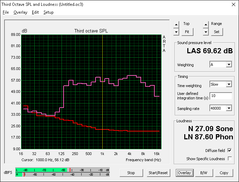
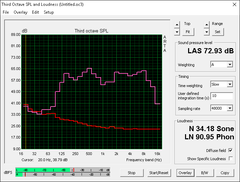
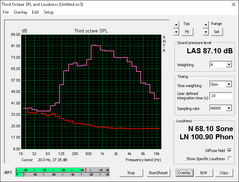
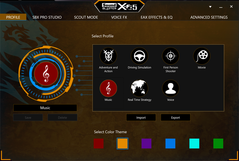
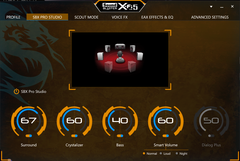
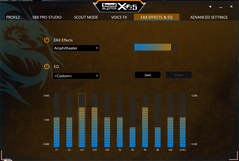
Eurocom Sky X7E2 audio analysis
(-) | not very loud speakers (69.6 dB)
Bass 100 - 315 Hz
(±) | reduced bass - on average 7% lower than median
(±) | linearity of bass is average (14.7% delta to prev. frequency)
Mids 400 - 2000 Hz
(+) | balanced mids - only 1.7% away from median
(+) | mids are linear (6.6% delta to prev. frequency)
Highs 2 - 16 kHz
(+) | balanced highs - only 3.5% away from median
(+) | highs are linear (6.6% delta to prev. frequency)
Overall 100 - 16.000 Hz
(±) | linearity of overall sound is average (16.4% difference to median)
Compared to same class
» 41% of all tested devices in this class were better, 6% similar, 52% worse
» The best had a delta of 6%, average was 18%, worst was 132%
Compared to all devices tested
» 26% of all tested devices were better, 6% similar, 68% worse
» The best had a delta of 4%, average was 24%, worst was 134%
Apple MacBook 12 (Early 2016) 1.1 GHz audio analysis
(+) | speakers can play relatively loud (83.6 dB)
Bass 100 - 315 Hz
(±) | reduced bass - on average 11.3% lower than median
(±) | linearity of bass is average (14.2% delta to prev. frequency)
Mids 400 - 2000 Hz
(+) | balanced mids - only 2.4% away from median
(+) | mids are linear (5.5% delta to prev. frequency)
Highs 2 - 16 kHz
(+) | balanced highs - only 2% away from median
(+) | highs are linear (4.5% delta to prev. frequency)
Overall 100 - 16.000 Hz
(+) | overall sound is linear (10.2% difference to median)
Compared to same class
» 7% of all tested devices in this class were better, 2% similar, 91% worse
» The best had a delta of 5%, average was 18%, worst was 53%
Compared to all devices tested
» 4% of all tested devices were better, 1% similar, 94% worse
» The best had a delta of 4%, average was 24%, worst was 134%
Frequency Comparison (Checkbox selectable!)
Graph 1: Pink Noise 100% Vol.; Graph 2: Audio off
Energy Management
Power Consumption
The Sky X7E2 is one of the most demanding 17-inch notebooks we've tested with a maximum recorded power draw of about 330 W when under extreme stress or about 260 W when under gaming loads. Both its CPU and GPU aren't exactly power efficient, either, so the Eurocom draws slightly more power than its closest competitors when idling or during very low loads. The deltas are significant at well over 100 W even when compared to the powerful MSI GT73VR with the i7-6820HK and GTX 1070.
The large power adapter itself (20 x 10 x 4.5 cm) is rated for a maximum of 330 W, so there is very little headroom (if any) when subjecting the system to extreme loads. In comparison, most gaming notebooks have power adapters rated for 10 to 20 percent higher than the maximum draw of the system. We don't recommend overclocking the X7E2 unless if it is configured with less demanding CPU or GPU options than what we have on hand. The system supports 2x 330 W AC adapters for a higher ceiling of 660 W, but core temperatures are still too high on our configuration for comfortable overclocking.
| Off / Standby | |
| Idle | |
| Load |
|
Key:
min: | |
| Eurocom Sky X7E2 6700K, GeForce GTX 1080 Mobile, Samsung SM951 MZVPV512HDGL m.2 PCI-e, IPS, 3840x2160, 17.3" | MSI GT73VR-6RE16SR451 6820HK, GeForce GTX 1070 Mobile, 2x Samsung SM951 MZVPV256HDGL (RAID 0), TN, 1920x1080, 17.3" | Asus G701VO-CS74K 6820HK, GeForce GTX 980 (Laptop), 2x Samsung SM951 MZVPV512HDGL (RAID 0), IPS, 1920x1080, 17.3" | Lenovo IdeaPad Y900 6820HK, GeForce GTX 980M, Samsung SM951 MZVPV256 m.2, , 1920x1080, 17.3" | MSI GT80S 6QF 6820HK, GeForce GTX 980 SLI (Laptop), 2x Samsung SM951 MZVPV256HDGL (RAID 0), Super PLS, 1920x1080, 18.4" | |
|---|---|---|---|---|---|
| Power Consumption | 26% | 30% | 39% | -17% | |
| Idle Minimum * (Watt) | 34.3 | 31 10% | 28.2 18% | 24.3 29% | 44 -28% |
| Idle Average * (Watt) | 42.9 | 35 18% | 32 25% | 29.6 31% | 53 -24% |
| Idle Maximum * (Watt) | 43.5 | 40 8% | 32.6 25% | 29.9 31% | 62 -43% |
| Load Average * (Watt) | 258 | 106 59% | 162.2 37% | 110.1 57% | 163 37% |
| Load Maximum * (Watt) | 329.8 | 218 34% | 173.5 47% | 171.4 48% | 411 -25% |
* ... smaller is better
Battery Life
Powering a notebook with a Core i7-6700K CPU and GTX 1080 GPU on batteries can only get you so far. Expect just under two hours of real-world WLAN use despite the relatively high capacity 89 Wh battery. Competing 17-inch gaming notebooks can last for about twice as long under the same conditions, though most do not carry deskop-class CPUs with LGA 1155 sockets. The battery for the Sky X7E2 is removable for easy swapping.
Charging from near empty to full capacity will take about 2.5 hours.
| Eurocom Sky X7E2 6700K, GeForce GTX 1080 Mobile, 89 Wh | MSI GT73VR-6RE16SR451 6820HK, GeForce GTX 1070 Mobile, 75.2 Wh | Asus G701VO-CS74K 6820HK, GeForce GTX 980 (Laptop), 93 Wh | Lenovo IdeaPad Y900 6820HK, GeForce GTX 980M, 90 Wh | MSI GT72VR 6RD-063US 6700HQ, GeForce GTX 1060 Mobile, 83 Wh | |
|---|---|---|---|---|---|
| Battery runtime | 65% | 60% | 119% | 89% | |
| Reader / Idle (h) | 2.3 | 4.8 109% | 4 74% | 5.8 152% | 5.4 135% |
| WiFi v1.3 (h) | 1.7 | 3.4 100% | 3.4 100% | 4.1 141% | 3.7 118% |
| Load (h) | 1.4 | 1.2 -14% | 1.5 7% | 2.3 64% | 1.6 14% |
Pros
Cons
Verdict
The Core i7-6700K and GTX 1080 are some of the most powerful consumer processors available and they are generally not offered together from other gaming notebook manufacturers. While the accessible LGA 1151 socket and MXM 3.0 slot help distinguish Clevo barebones from the ocean of competitors, our configured CPU and GPU prove to be a bit too much for the P775DM3 chassis to handle. No matter how you spin it, a core temperature higher than 90 C when gaming at stock speeds is enough to get any gamer feeling uneasy. Even if users have no qualms about the high running temperatures, fan noise is still noticeably louder than 17-inch alternatives that carry weaker hardware. Combine this with a maximum power demand that essentially reaches the capacity of the 330 W power adapter and you have a configuration that feels limited by the P775DM3 chassis.
Fortunately, the system shows no signs of major throttling when gaming as CPU and GPU benchmarks are where we expect them to be for the i7-6700K and GTX 1080, respectively. This is enough to make the Sky X7E2 one of the fastest 17-inch gaming notebooks available not accounting for systems with GTX 10 SLI options. The extreme components come at the real cost of heat and noise and users may want to consider a lower-specced configuration that would be more appropriate for the cooling solution of this particular barebones.
Operating temperatures and fan noise are uncomfortably high when gaming. If users can look past this, then the Sky X7E2 offers one of the most powerful gaming experiences available on a notebook this size. Otherwise, users may want to consider the Sky DLX7 or MSI GT73VR for their larger cooling systems.
Eurocom Sky X7E2
- 10/03/2016 v5.1 (old)
Allen Ngo




